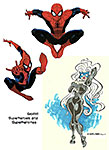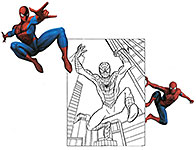SEXISM IN SUPERHERO FUNNYBOOKS
Where’s the Junk, Man?
AMONG THE IMAGES that accompanied presentations at a session about comic books at a Sandy Eggo Comic-Con several years ago were some that showed Spider-Man cavorting through the air over New York City, resplendent in his skin-tight spidey regalia, and, from presenter Jennifer Stuller, comic book panels that illustrated her premise that the comics were sexist because of the way women were depicted—typically in scanty or skin-tight attire that emphasized healthy protrusions for breasts and lustily rounded mounds for buttocks.
 |
 |
As you can readily imagine, it was more than I could sit still for. And so, as I said in Opus 280, I didn’t sit still: I arose and delivered myself of a harangue along these lines:
“I don’t exactly want to ask a question, Jennifer. Instead, I’d like you to come with me on a short safari of exploration and, if we’re lucky, discovery. We start out at a familiar domestic crisis—one that has been going on for as long as there’ve been indoor toilets—when, at the very onset of every marriage, the wife insists that her husband put the lid down. Every wife launches into wedded bliss with this demand. Oddly, no husband that I ever heard of has ever complained to his helpmate that she never leaves the lid up.
“No, and thus the fundamental inequity that distinguishes the relations between the sexes is re-established with every nuptial bond, and the same injustice is perpetuated throughout society at large in all its cultural venues. And so it is that men are forever reconstituted as the compliant gender.
“And because we are the compliant gender, we never complain that the charges of sexism in comics always conveniently neglect to mention the emasculation represented in the visual ravages committed on male anatomy.”
“I referred, then, to the pictures we’d seen of Spidey flinging himself around the New York skyline. In many of these images—particularly those full-frontal poses with legs akimbo—it is obvious that something is missing. Spidey is not equipped with the usual male package. He has no genitalia. He has been completely, and thoroughly—and literally—emasculated.
 |
 |
“The artists who draw Spider-Man and all other superheroes dutifully obey the laws that govern comic book illustration and deliberately eschew making pictures that hint at the male apparatus. But not without unintended consequences,” I said.
“As Freud established long ago,” I continued, “a repressed impulse always seeks a way to express itself—as water will always seek a downhill path. Prohibited from depicting that part of the male anatomy that Anthony Weiner famously brought into prominent public view, artists unconsciously seek respite from repression by drawing boobs and buttocks on female characters. They exaggerate these obvious attributes of the sex, focusing on them. The explanation for this preoccupation is simple: hooters subconsciously substitute for weiners. And so what you see, Jennifer, as sexism of a supposedly anti-feminist persuasion is actually a perverse manifestation of the male’s unconscious aspiration to equality between the sexes.”
Jennifer responded. She tried to explain. But I suspect she missed what I intended as satire. I shouldn’t have done it, I realize. It was a cruel if not also crude joke. Do I really believe that drawing boobs and buttocks acts unconsciously as a rebellious attempt to assuage internal tension brought on by obeying the commandment to emasculate superheroes? No.
But it sounds fairly convincing, cloaked, as it is, in the contextual robes of academic theoretical argot. And in the context of such often far-fetched theories, my analysis even makes a sort of rough sense. Perhaps, even, as Bernard Shaw has claimed, “every jest is an earnest in the womb of time.”
In perpetrating my jest, I seem to be ridiculing academics and their seriousness of purpose. And, of course, I am—the deadly seriousness but not the purpose. In fact, I was motivated by mixed emotions.
Comics have enjoyed nearly overwhelming academic attention in recent years. Seriously purposed tomes have been coming forth regularly for over two decades—more with each passing year as “comics studies” achieve a kind of intellectual legitimacy in the ivied halls of academe.
All the attention makes me a little uneasy. I keep thinking of Bernard Shaw’s adamant refusal to let any of his plays be published in American literature anthologies for use in classrooms. He thundered that American attempts to teach Shakespeare had ruined the Bard for generations of readers/audiences, and he didn’t want his plays to suffer the same vandalism. (And as long as he lived, none of his plays were included in literature textbooks.)
By the same token, I don’t want enjoyment of comics to be destroyed by academic excesses in well-intentioned but often misguided attempts to enhance our appreciation of the medium.
On the other hand, academic interest in motion pictures fostered the notion of film as an artform. Without the attention that the professorial legions lavished on watching movies, motion pictures might never have achieved status as art.
In like manner, the academy’s embrace of comics has undeniably helped in raising the cultural status of the medium. I suspect, however, that a burgeoning fandom, beginning in the 1970s—demanding higher quality “European-like” reproduction in comics products—had an even larger role in the levitation.
And once comics specialty shops staked out turf for the medium thereby defining a market, publishers took notice and began to produce works that appealed to that market. Resulting, soon, in the emergence of a superior kind of comic book—the awfully misnamed “graphic novel.”
Still, interest manifest in the ivied halls of academe can’t hurt. Unless Shaw is right.
Pinioned by the horns of this dilemma, I surrendered to temptation and committed my joke about boobs and buttocks and missing danglers. As I said, I probably shouldn’t have done it. (Then again, I’m probably attaching more importance to my foray into satire than anyone there did.)
(I may even be seeing satire where no one else did. It wouldn’t be the first time that I’ve been subtle to the point of vague.)
Jennifer Stuller seemed a knowledgeable and pleasant person and certainly didn’t deserve my tongue-in-cheek tirade. Or maybe—
Maybe the perennial attacks on comics as conveyances of sexist attitudes warrant a little healthy ridicule. The charge of sexism in comics has been around for at least a generation. And I’m pretty sure that in all that time it has had little effect on the way superheroines and other female characters are drawn.
The sexist charge turns on the issue of sex objectification: to portray women as sex objects turns them into sexual playthings, leaving individual personality out altogether. But the sex object gambit is simply rhetoric: in the early years of the feminist crusade, the function of the rhetoric was to draw attention to the gender inequality fostered by our culture. I had a woman friend whose last name was Goodman, and she seriously contemplated changing her last name to “Goodperson.”
She didn’t, but if she had, she would have been deploying a rhetorical device to emphasize the extent to which maleness dominated Western culture. And the dominance of maleness effectively undermined any consideration of women as individual personalities.
Useful as such rhetoric may have been at the beginning, it long ago became a threadbare ploy. Everyone realizes—and even admits—that humanity falls into two sexes and that each is attractive to its opposite as a means of guaranteeing propagation of the species. Fashions in wardrobe emphasize those aspects of one gender’s physical appeal to the other.
I naturally observe women’s fashions more than men’s, and everything about women’s fashions—not haute couture, but the design of everyday wardrobe—is intended to enhance the female’s appeal to the male. In short, sex appeal.
I observed some years ago that cleavage had returned; and breasts that bounce when their owner walks is likewise a fashion statement about sex appeal. And that is the way it should be.
What shouldn’t be as a result is gender inequality in social or political or occupational realms. But surely we’ve progressed beyond sex object allegations as the means by which the inequality can be noticed and, perforce, remedied.
To
the extent that there are other worthwhile things in life than sex, so should
women (and men) be seen as something more than sex objects. And that requires a
cultural maturity that goes beyond mere rhetoric. Stuller (calling her
“Jennifer” is clearly sexism of a  demeaning sort, implying that she’s a “girl”
rather than a professional woman) is charging into battle against sexism with
out-dated weapons.
demeaning sort, implying that she’s a “girl”
rather than a professional woman) is charging into battle against sexism with
out-dated weapons.
In short, some things deserve to be laughed at as a way of moving beyond them. So maybe my joke wasn’t in such bad taste as all that.
In the meantime, as we muster forces with newer weapons, we can still pause to celebrate the eternal feminine, which I do here. We don’t want the winter to fade into spring and then summer without a preparatory swimsuit shot; herewith—:
